
This is Part 1 of a three part series. Check out Part 2: Contributors and Product or Part 3: Management and Scale if that’s more relevant for you.
Yes it’s trite, but it really is true: building a team is the single most important task startups do on their journey. There are droves of resources out there for helping software startups build teams but less so for hardware startups. Frustratingly, building teams for hardware companies can be notably different in a few key ways:
- Early stage hardware startups often need more people hours to ship a first product.
- Hardware startups often involve multiple outside players (consultants, design firms, manufacturers, retailers, etc) and setting up these relationships strategically is tricky.
- Differences in hardware and software management tend to drive more complex organizational structures.
- Making small mistakes with team and product early on in a hardware company can cause disproportionate pain down the road (the long shadow effect).
This three part blog series will share a set of frameworks to aid hardware startups in building the oft-cited “A+ team.”

Most advice about team building focuses on hiring full-time employees. While hiring is one of the most difficult things to get right, exclusively focusing on employees does not provide a complete picture of how most hardware startups get product to market and scale. Many different types of people and business relationships are fundamental to hardware startups, and as a bit of a space dork, I tend to think about teams as a solar system of people:
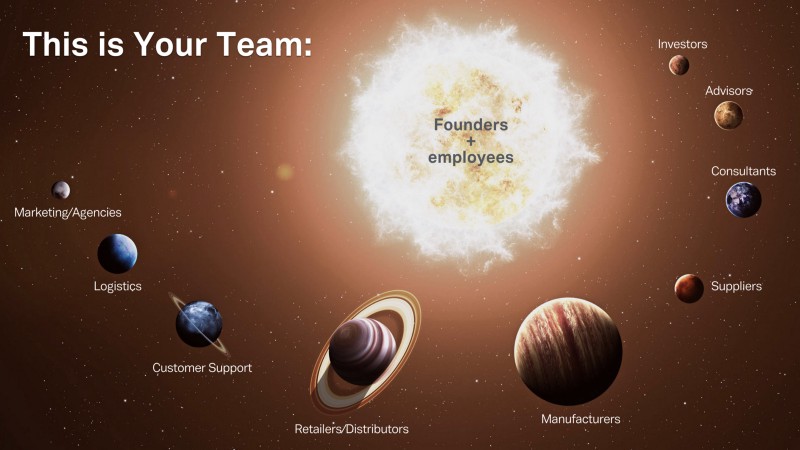
While the highest density of energy is the founders and employees (the sun), building a scalable hardware business requires collaboration with many different partners (the planets). The entire solar system of people is critical to your vision.
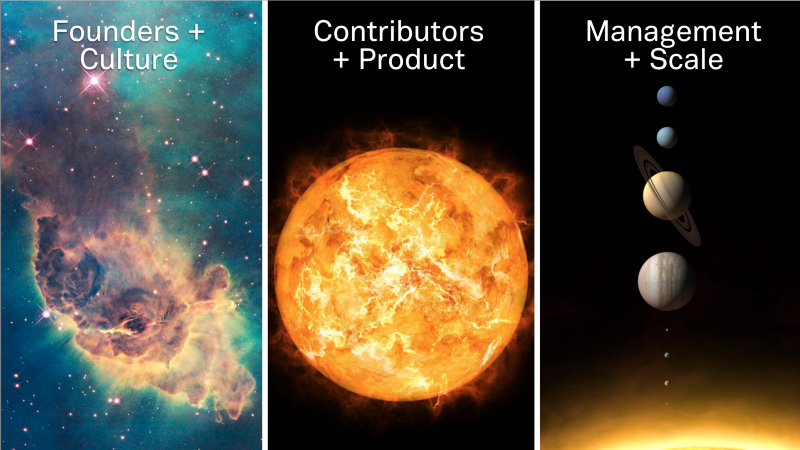
It’s helpful to break the team building process into three unique stages of company growth over time:
- Founders and Culture — this section focuses on the founding team and the culture they instill in the company. This stage of team building is all about laying the foundation for attracting the right types of people down the road.
- Contributors and Product —this section focuses on early contributors and the people required to build the first product. This stage of team building is all about validating the primary assumptions of the company and that product/market fit can be found.
- Management and Scale — this section focuses on the management team and scaling the company to attain market dominance. This stage of team building is all about company structure and repeatable growth.

All startups begin by staring into the cold, dark nothingness of space. The tiny hope of an idea and the fusion of the founding team creates the Big Bang that brings matter and light into an otherwise empty existence.

The best founding teams create a chemical reaction akin to nuclear fusion that produces an astounding amount of energy. This reaction attracts both employees and investors, and enables everything in the solar system of the company to exist. I can’t overstate this enough: selecting your co-founder is the most important decision you make when starting a company.

There’s a long list of famous founding teams. Their financial success and world-changing trajectory was built on the backs of a seemingly magical combination of skills, backgrounds, and networks that enable companies to attract world-class talent, investors, and customers.

In my experience meeting thousands of founders over the past few years, I’ve noticed that the best individuals share a few common characteristics. In particular, resiliency is a quality that is highly correlated with success. A great example is the AirBnB founders making novelty breakfast cereal as a marketing tool, and then living off of it when they failed to sell enough Cap’n McCain Crunch.
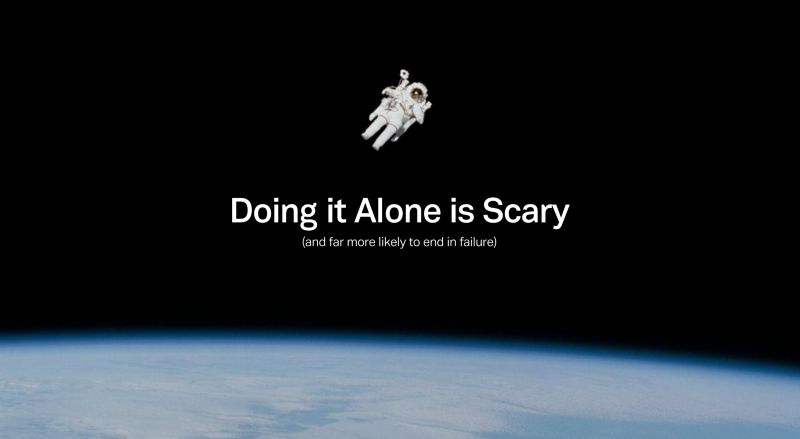
Getting the right individual founder in a company is important, but data shows you are significantly less likely to succeed without a co-founder. While Bolt has invested in a handful of single-founder companies, we often spend the first few months helping that person find the right co-founder. This is especially critical in hardware companies where so many disciplines are involved to build a product.
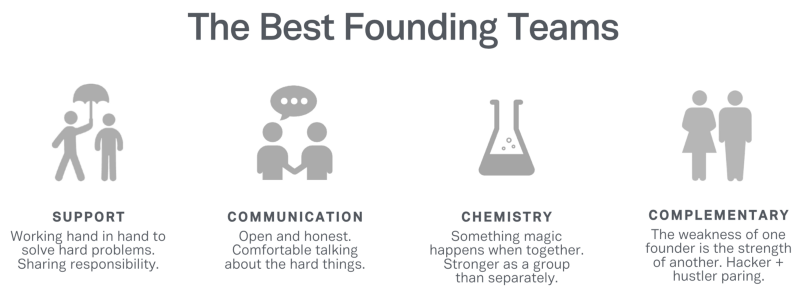
Like the best individuals, the best co-founding teams share a set of common characteristics. Arguably, the most important one is healthy communication. Communication is the oxygen that allows all other parts of the co-founder relationship to flourish. If you’re a sole founder thinking about building a founding team, complimentary skill sets tend to be another influencer of long-term success. The common makeup of one “hacker” (technical savant) and one “hustler” (business visionary) is the gold-standard in founding teams, but other configurations can work as well. With hardware teams, we nearly always prefer co-founders with complementary technical backgrounds (e.g. one mechanical engineer, one software engineer, and one supply chain manager) with one person taking lead on all things business (most people call this person the CEO).
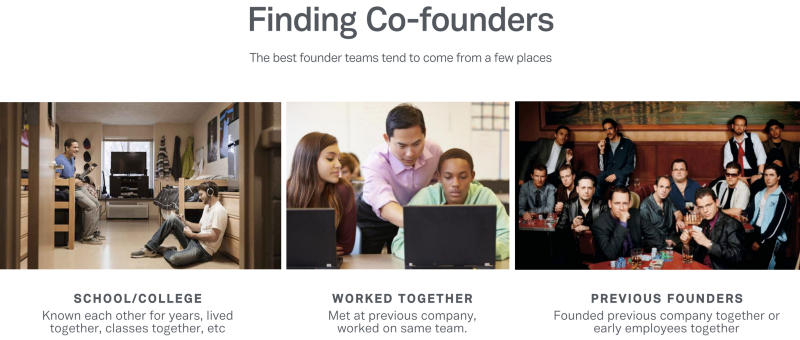
Many solo entrepreneurs know they need one or two additional founding teammates, but the tactics of finding them can be tough. The best co-founders often:
- Went to school/college together. Sharing formative life experiences is a great way to create strong bonds and solid relationships. It’s no surprise then, that college roommates and friends make common co-founder pairings.
- Worked together at an established company. Witnessing how someone works over a long period of time, even in a big company environment, is a good indicator of how they will deal with the ups and downs of a small startup.
- Previous Co-founders. This is definitely the least common situation but also the biggest positive signal investors/employees can get. Founders that have already been through the emotional rollercoaster of starting a company are much more likely to stick together through the tough times.

Casual meetings on LinkedIn or founder dating programs have a very low likelihood of creating the type of relationship that’s necessary for building a robust startup. They can occasionally lead to strong, life-long relationships but a small fraction of successful founders meet this way.

Once you believe you have the right co-founder(s) around the table, setting up the relationship correctly is a critical next step. Fights between co-founders create catastrophic situations that are bad for everyone. Here are a few tips that have worked well for me and our portfolio companies:
- Sit down as a co-founding team and write a list of each person’s responsibilities. You can do this together, or perhaps more interestingly, as a blind exercise.
- Have hard conversations early. Here are a few critical ones: how to divide equity (50:50 often isn’t right), what would trigger each founder to leave, what is needed for each founder to stay, how/when to shut the company down, and how much cash compensation is necessary for each founder.
- Put all of this in writing and sign/save it!
- Throughout these conversations you’re optimizing for zero surprises. You should never have the feeling of “oh shit!” with a co-founder. Don’t worry, you’ll have plenty of “oh shit!” moments with other things.
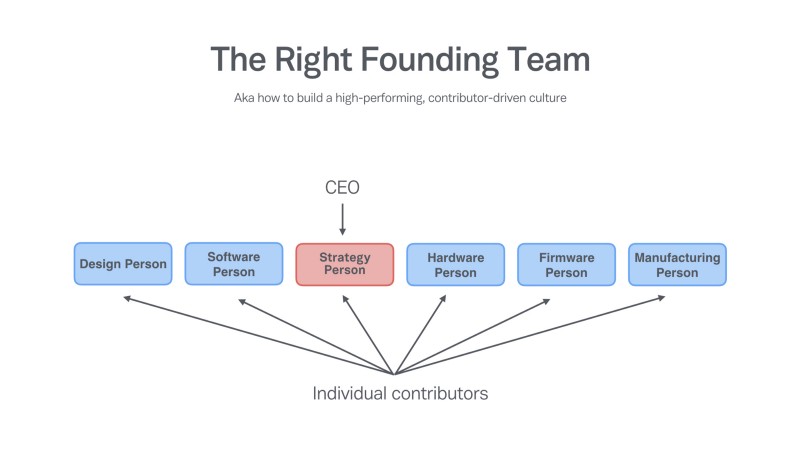
With the right founding team, everyone is an individual contributor. The dominance of individual contributors (rather than managers) often lasts for a year or longer. Many of the best companies focus on hiring individual contributors and internally promote managers after seeing them in action.
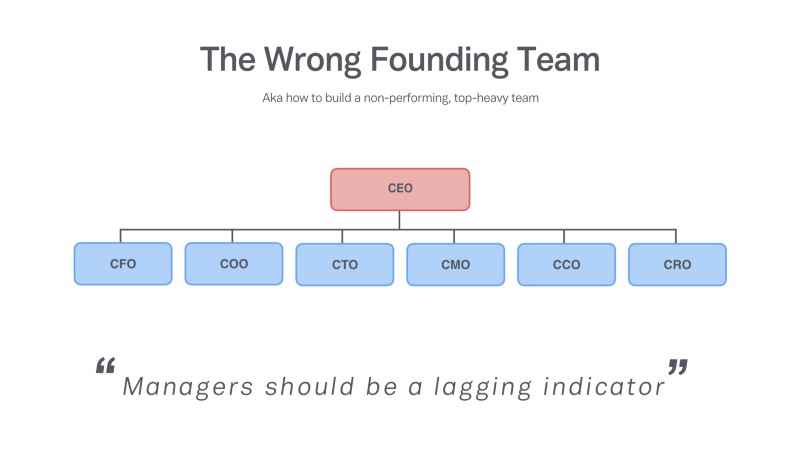
Unfortunately, we often see startups with “top heavy” teams. Their organization structure looks like someone cleaved off the top part of a huge public company and stuck it on a slide deck. This is not the right DNA for an early stage hardware company. You should always feel like you need more managers.

Even if you’ve done a great job attracting a stellar co-founder to your vision, keeping your relationship healthy is a completely different matter. Many founders believe they’re too busy to spend time on the “soft stuff”. Those founders nearly always separate. Here are a few tools I’ve seen keep founding teams strong:
- Get Out of the Office. Interacting in a single environment can cause relationships to feel stagnant. Spending time outside of work, vacationing together, and spending time with non-work people can help reinvigorate co-founder relationships and keep them healthy.
- Take Time Apart. Like any relationship, spending time alone is healthy. I try really hard to spend a few weeks per year completely off the grid with no email and no expectations of work of any kind. More often than not, I come back with a new idea, extra passion for something I’m working on, and increased excitement for getting back to the office.
- Get a Coach. Every startup has tons of people surrounding the founders providing all sorts of advice, but rarely is that advice geared towards the emotional psyche of the founder(s). Many of the highest performing CEOs have management coaches that provide an impartial voice about mental health, management issues, and personal struggles. I can’t say enough good things about Jerry Colonna and Reboot, but there are many good coaches out there.
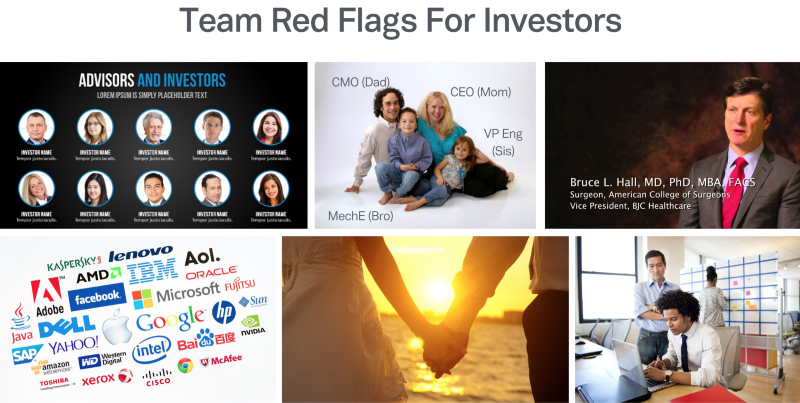
When your founding team is out raising money from angels and VCs, here are a few things to avoid (if possible):
- Piles of Advisors. Early investors are backing the founders, not part time advisors or previous investors. Don’t spend time talking about them unless there’s some critical risk they help you mitigate (and even then, be careful).
- A Family Affair. Families can be great at certain things. Turns out, running fast-growing startups often isn’t one of them. Most investors are very wary of early teams with family members or romantic relationships. There are exceptions to every rule, but if your co-founder relationship(s) fall into this category, be sure to have a well-prepared answer for why this makes sense for the company.
- Stage/Background Misfit. Over-qualified founders with many academic degrees or long tenures at big companies can sometimes be worse than under-qualified founders looking to build an exceptional new career.
- Third Wheel Syndrome. Don’t bring non-founders to pitch your company, especially during the first meeting. Having an informal advisor in the room often creates a bizarre dynamic that only hurts your ability to excite investors.

Another red flag for investors (and one we see so often it’s worth pointing out separately) is a geographically distributed team. While there are cases where dispersed teams work well, it’s yet another variable you have to account for and overcome. Better to not deal with it until you’re a larger company with lots of momentum. This is particularly true when there’s a hardware product you’re developing.

Many founders at the highest-performing companies credit much of their success to what we call an “early stage board member.” Early stage board members are very different than those who serve on the boards of public companies. When you get a top-tier venture capital firm to lead your Series A, the most valuable thing you’re getting is an early stage board member. Here’s why they’re so helpful (and why you should work hard to get the right one):
- Leverage. Early stage board members tend to be experienced operators of venture-scale businesses that have seen the process of starting and scaling companies many, many times. One conversation with this type of board member can quickly short-circuit a long process of figuring out major issues: what type of person to hire, what go-to-market strategy to use, or how to pitch the company. CEOs that learn to leverage their board members tend to run circles around those that try to figure everything out themselves.
- Accountability. Early stage board members are good at holding management teams accountable when it comes to deadlines, hiring goals, projections, and even revenue. Without accountability, startups often struggle to get into an operational cadence that builds systematic growth.
- Network. Early stage board members often have vastly different networks than new CEOs/founders and can leverage their relationships to help with hiring and management.
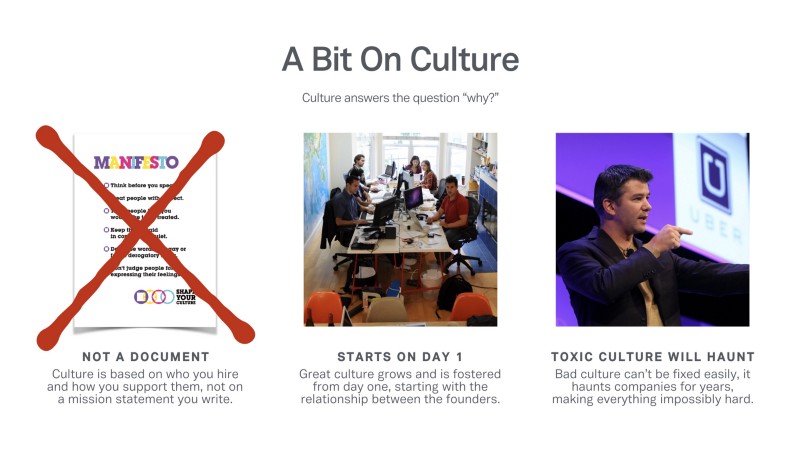
An organization’s culture is one of the only sustainable competitive advantages that is within the control of the entrepreneur. In the best case, you get a community of amazingly driven people, working efficiently together in pursuit of shared goals and aspirations. In the worst case, you get a loose association of over-worked, political cynics with competing interests and motivations.
- Culture is NOT a Document. Culture is the repeated and accepted behaviour of an organisation. It is a set of shared practices, attitudes, and goals that define a company. Manifestos like the Zappos culture book or Valve new employees handbook are the RESULT of culture, not its source.
- Starts on Day 1. Culture is created, intentionally or not, by the repeated decisions and activities of founders and early hires. Are you obsessed with customer feedback? Do you listen to new ideas? Do you show up on time? Do you expense fancy dinners? Do you value diversity? Do you encourage risk taking? One-off decisions in the early years become organisational norms as a company grows.
- Toxic Culture Will Haunt. Uber is probably the best recent example of a dominant business crippled by toxic culture (that started at the top). Be hypersensitive to any indicators that your culture is turning great people off.
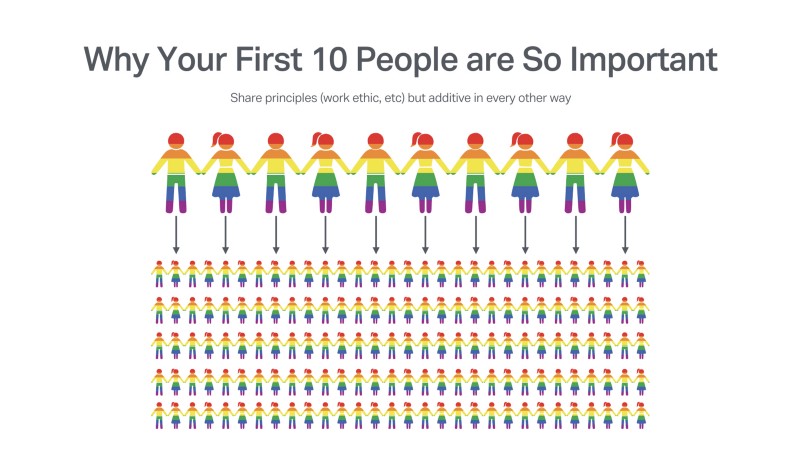
Diversity is such an important piece of culture it’s worth a separate callout. Diversity in all dimensions (gender, race, thought, background, age, sexual orientation, perspective, etc) is a powerful tool that excellent companies foster from the earliest days. Your first ten hires will select your next hundred, so building a diverse early team will help you reap rewards for years to come.
Now that we’ve built a solid founding team and culture, it’s time to think about building the team to create the first hardware product. Check out Part 2: Contributors and Product.
Ben Einstein was one of the founders of Bolt. You can find him on LinkedIn.
Bolt invests at the intersection of the digital and physical world.
